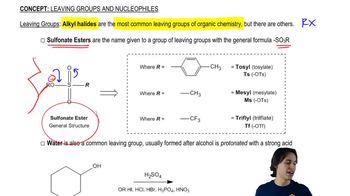Explain how the following changes affect the rate of the reaction of 2-bromo-2-methylbutane with methanol:
a. The alkyl halide is changed to 2-chloro-2-methylbutane.
b. The alkyl halide is changed to 2-chloro-3-methylbutane.

 Verified step by step guidance
Verified step by step guidance Verified video answer for a similar problem:
Verified video answer for a similar problem:



 0:38m
0:38mMaster Intro to Substitution/Elimination Problems with a bite sized video explanation from Johnny
Start learning